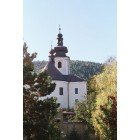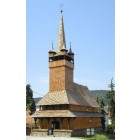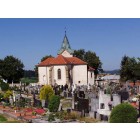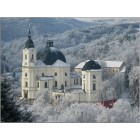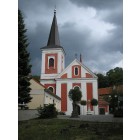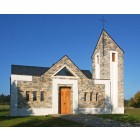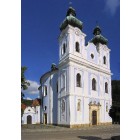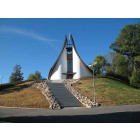Blansko
The originally Romanesque, now Baroque, Saint Martin’s Church. The Way of the Cross from the end of the nineteenth century and the copy of Myslbek’s Crucifixion are particularly noteworthy. The ancient bell in the church tower, which is widely considered one of the oldest bells in Moravia, is a rare example of the bell-founder’s art. A commemorative plaque to Caroline Meineke has been installed in the immediate vicinity of the church on the site of the original cemetery.
The Wooden Church from the middle of the seventeenth century is a unique sight in Blansko. It was originally located in Nyzhni Selyschtsche in Sub-Carpathian Ukraine and is consecrated to the Orthodox Saint Paraskeva. An icon of the saint and a number of other icons from the original ornamentation have remained preserved as examples of Ukrainian folk art. The church is an example of the “Transylvanian-Marmaros” type of Ruthenian church influenced by the Western European Gothic. In the opinion of a number of experts, it is the oldest church of its type in this country.
Křtiny
The Baroque Marian Church of the Name of the Virgin Mary, often known as the “Pearl of South Moravia”, was built from plans by Jan Blažej Santini. It is his largest work, built on the ground plan of a Greek cross. It has become a famous pilgrimage site thanks to its statue of the Madonna, to which a number of miracles have been credited.
Sloup
The Late Baroque Church of Our Lady of Sorrows by M. A. Canevalle from the eighteenth century. The altar made from black and red marble with a Gothic statue of The Pietà. Members of the aristocratic Salm family lie in rest beneath cast-iron gravestones in the local cemetery.
Jedovnice
The originally Early Baroque Church of Saints Peter and Paul. The modern design of the main altar, made according to designs by the distinguished artists Jan Koblasa and Mikuláš Medek, is unique of its kind in Europe.
Adamov
The Neo-Gothic Saint Barbara’s Church. The Zwettl Altar, originally from the Cistercian Abbey in Zwettl, Austria, is a superb feature in the interior of this brick building. This Late Gothic carving is, in its way, a unique work of art.
Senetářov
The modern Saint Joseph’s Church built in the twentieth century from designs by Ludvík Kolek. Its shape resembles that of a ship as an image of the church collecting believers on their journey through life and leading them to the greatest good – God.
Lipovec
The Neo-Gothic Church of the Nativity of the Virgin Mary. The picture of the Nativity of the Virgin Mary on the main altar from 1850 is by Matěj Šťastný. A modern Way of the Cross by painter Sabina Kratochvílová, M.A.
Šebrov-Kateřina
The Church of Saint Katherine (probably built in 1469) standing on a hill in the middle of Šebrov-Kateřina is unique primarily for the fact that it has been preserved in its original Late Gothic form without later Baroque or Neo-Gothic alterations.
Bořitov
Saint George’s Church was established at the turn of the twelfth and thirteenth centuries during the Early Romanesque period. The original church was probably made of wood. Today’s church is built out of blocks of chalk. The nave, featuring vaulting from the nineteenth century, is the oldest part of the church. The church has a quadrilateral tower from the beginning of the fourteenth century. A crypt for the aristocracy, where the patrons of the local church were buried, is located underground near the middle of the church.
Bukovinka
According to documentation, the filial Church of the Assumption of the Virgin Mary stood in Bukovinka in the thirteenth century on the site of the old cemetery. The old church was destroyed by fire in 1772 (only its ruins now remain) and the current church was built the following year. It is thirty-seven metres high and was built on a nearby elevation on the southern edge of the village.
Dlouhá Lhota
The present church was built in 1804 and consecrated to Saint Bartholomew. Its chalice, which dates back to 1403, is particularly noteworthy. It was made from pure gold and decorated with gemstones, though these have been stolen and replaced with glass stones.
Doubravice nad Svitavou
The Church of Saint John the Baptist stands on the southern edge of the town. A new church was built in the eighteenth century on the site of an old demolished church. There are three altars in the church. The clock in the tower is from 1851.
Holštejn
A chapel was built here on a hill in 1769. It was ceremonially consecrated in 1773 and dedicated to Saint Anne. Saint Anne’s Chapel was converted into a small church in 1815.
Kotvrdovice
The Chapel of the Divine Heart of the Lord, with its altarpiece of the Most Sacred Heart by Mikuláš Medek, is the most important cultural building in the village. The chapel is said to have been built during the Second World War next to an existing bell tower. The original wooden altar was removed in 1985 and a new sacrificial table, an ambon, a tabernacle and an altarpiece, along with a marble sculpture around it, were installed. The interior of the presbytery (the sacrificial table, the ambon and the tabernacle) was designed by Ludvík Kolek.
Petrovice
The present church was built in 1733–1735 by its patron Karel of Roggendorf, owner of the Rájec estate. It was built on the site of the old original church. A number of old crosses and heraldic stones (the graves of noblemen) and a small grave in which a corpse lay in a long black gown with a book in its hand were found in the foundations of the old church while it was being pulled down. The tomb was subsequently sealed off again. The records about the grave from that time do not state whether the corpse was that of a man or a woman. All that remained of the old masonry was the right-hand wall from the main entry to the presbytery. The church was consecrated on 6 October 1735.
Újezd u Černé Hory
This church is a single-nave structure with an extended presbytery and an apse, a tower and a sacristy. It was built at the beginning of the thirteenth century as a sanctuary for the aristocracy in the Romanesque style, evidence of which is the entry portal on the south side. The oldest surviving record of the church is an entry from 1308 by parish priest Jakub of Újezd.
The originally Romanesque, now Baroque, Saint Martin’s Church. The Way of the Cross from the end of the nineteenth century and the copy of Myslbek’s Crucifixion are particularly noteworthy. The ancient bell in the church tower, which is widely considered one of the oldest bells in Moravia, is a rare example of the bell-founder’s art. A commemorative plaque to Caroline Meineke has been installed in the immediate vicinity of the church on the site of the original cemetery.
The Wooden Church from the middle of the seventeenth century is a unique sight in Blansko. It was originally located in Nyzhni Selyschtsche in Sub-Carpathian Ukraine and is consecrated to the Orthodox Saint Paraskeva. An icon of the saint and a number of other icons from the original ornamentation have remained preserved as examples of Ukrainian folk art. The church is an example of the “Transylvanian-Marmaros” type of Ruthenian church influenced by the Western European Gothic. In the opinion of a number of experts, it is the oldest church of its type in this country.
Křtiny
The Baroque Marian Church of the Name of the Virgin Mary, often known as the “Pearl of South Moravia”, was built from plans by Jan Blažej Santini. It is his largest work, built on the ground plan of a Greek cross. It has become a famous pilgrimage site thanks to its statue of the Madonna, to which a number of miracles have been credited.
Sloup
The Late Baroque Church of Our Lady of Sorrows by M. A. Canevalle from the eighteenth century. The altar made from black and red marble with a Gothic statue of The Pietà. Members of the aristocratic Salm family lie in rest beneath cast-iron gravestones in the local cemetery.
Jedovnice
The originally Early Baroque Church of Saints Peter and Paul. The modern design of the main altar, made according to designs by the distinguished artists Jan Koblasa and Mikuláš Medek, is unique of its kind in Europe.
Adamov
The Neo-Gothic Saint Barbara’s Church. The Zwettl Altar, originally from the Cistercian Abbey in Zwettl, Austria, is a superb feature in the interior of this brick building. This Late Gothic carving is, in its way, a unique work of art.
Senetářov
The modern Saint Joseph’s Church built in the twentieth century from designs by Ludvík Kolek. Its shape resembles that of a ship as an image of the church collecting believers on their journey through life and leading them to the greatest good – God.
Lipovec
The Neo-Gothic Church of the Nativity of the Virgin Mary. The picture of the Nativity of the Virgin Mary on the main altar from 1850 is by Matěj Šťastný. A modern Way of the Cross by painter Sabina Kratochvílová, M.A.
Šebrov-Kateřina
The Church of Saint Katherine (probably built in 1469) standing on a hill in the middle of Šebrov-Kateřina is unique primarily for the fact that it has been preserved in its original Late Gothic form without later Baroque or Neo-Gothic alterations.
Bořitov
Saint George’s Church was established at the turn of the twelfth and thirteenth centuries during the Early Romanesque period. The original church was probably made of wood. Today’s church is built out of blocks of chalk. The nave, featuring vaulting from the nineteenth century, is the oldest part of the church. The church has a quadrilateral tower from the beginning of the fourteenth century. A crypt for the aristocracy, where the patrons of the local church were buried, is located underground near the middle of the church.
Bukovinka
According to documentation, the filial Church of the Assumption of the Virgin Mary stood in Bukovinka in the thirteenth century on the site of the old cemetery. The old church was destroyed by fire in 1772 (only its ruins now remain) and the current church was built the following year. It is thirty-seven metres high and was built on a nearby elevation on the southern edge of the village.
Dlouhá Lhota
The present church was built in 1804 and consecrated to Saint Bartholomew. Its chalice, which dates back to 1403, is particularly noteworthy. It was made from pure gold and decorated with gemstones, though these have been stolen and replaced with glass stones.
Doubravice nad Svitavou
The Church of Saint John the Baptist stands on the southern edge of the town. A new church was built in the eighteenth century on the site of an old demolished church. There are three altars in the church. The clock in the tower is from 1851.
Holštejn
A chapel was built here on a hill in 1769. It was ceremonially consecrated in 1773 and dedicated to Saint Anne. Saint Anne’s Chapel was converted into a small church in 1815.
Kotvrdovice
The Chapel of the Divine Heart of the Lord, with its altarpiece of the Most Sacred Heart by Mikuláš Medek, is the most important cultural building in the village. The chapel is said to have been built during the Second World War next to an existing bell tower. The original wooden altar was removed in 1985 and a new sacrificial table, an ambon, a tabernacle and an altarpiece, along with a marble sculpture around it, were installed. The interior of the presbytery (the sacrificial table, the ambon and the tabernacle) was designed by Ludvík Kolek.
Petrovice
The present church was built in 1733–1735 by its patron Karel of Roggendorf, owner of the Rájec estate. It was built on the site of the old original church. A number of old crosses and heraldic stones (the graves of noblemen) and a small grave in which a corpse lay in a long black gown with a book in its hand were found in the foundations of the old church while it was being pulled down. The tomb was subsequently sealed off again. The records about the grave from that time do not state whether the corpse was that of a man or a woman. All that remained of the old masonry was the right-hand wall from the main entry to the presbytery. The church was consecrated on 6 October 1735.
Újezd u Černé Hory
This church is a single-nave structure with an extended presbytery and an apse, a tower and a sacristy. It was built at the beginning of the thirteenth century as a sanctuary for the aristocracy in the Romanesque style, evidence of which is the entry portal on the south side. The oldest surviving record of the church is an entry from 1308 by parish priest Jakub of Újezd.


